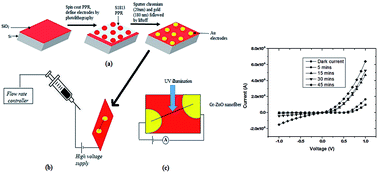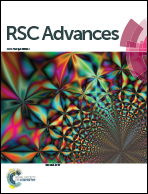One-step in situ synthesis of single aligned graphene–ZnO nanofiber for UV sensing†
Abstract
Here, we report a simple, one-step method for the in situ synthesis and alignment of a single graphene-doped zinc oxide (Gr–ZnO) composite nanofiber fabricated by electrospinning across electrodes and its subsequent use for ultraviolet (UV) detection. The study involves the optimization of the calcination temperature and time-dependent electrospinning for alignment of the Gr–ZnO composite nanofiber across gold electrodes. SEM analysis and Raman studies revealed the presence of ZnO embedded within uniformly distributed Gr flakes throughout the surface of the composite fiber. XRD analysis of Gr–ZnO confirmed a highly crystalline ZnO structure with amorphous graphene. Different weight percentages of graphene flakes were used to synthesize the composite to determine the optimum composition that enabled the synergistic contribution of both ZnO and graphene for UV sensing. I–V measurements under UV illumination showed that the composite to exhibit superior UV sensing performance with a ∼1892-fold increase in conductance for 0.5 wt% of graphene. The underlying mechanism of charge transfer of photogenerated electrons and holes from ZnO to graphene under UV illumination was studied. The method presented in this study provides a simple, effective and economically viable strategy for the alignment of various composite fibers and can therefore be used in a wide range of sensing applications.


 Please wait while we load your content...
Please wait while we load your content...